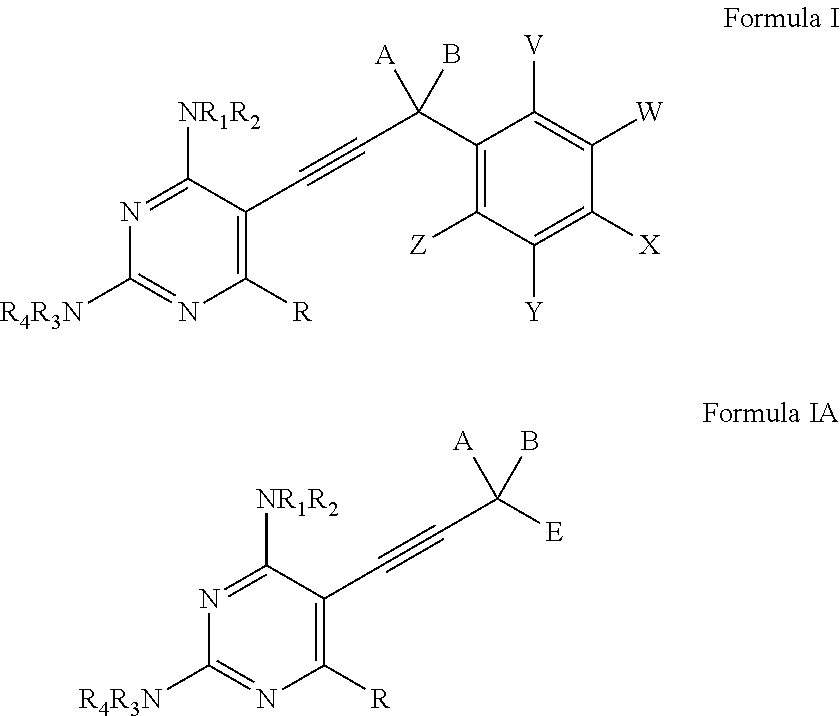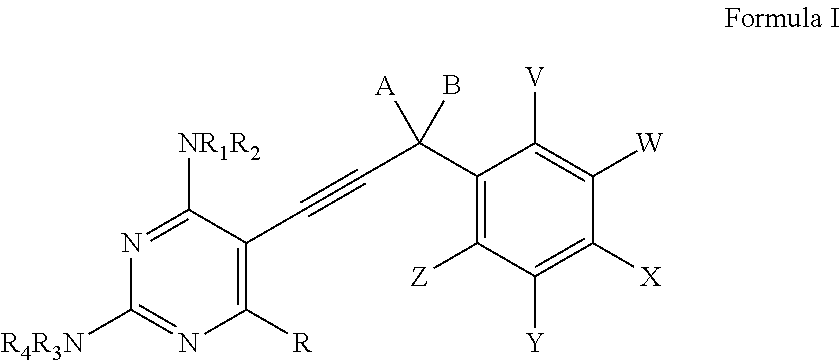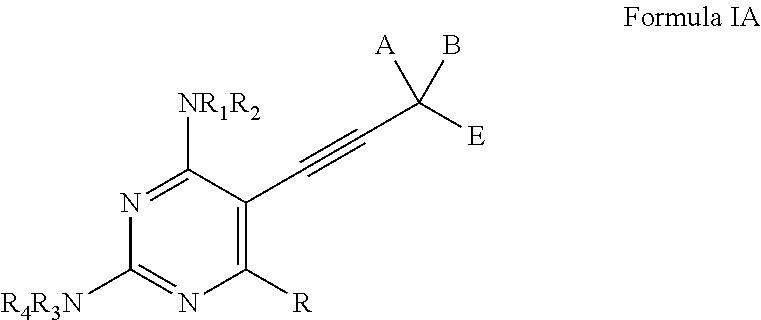Heterocyclic and Cyclic Analogs of Propargyl-Linked Inhibitors of Dihydrofolate Reductase
a dihydrofolate reductase and analog technology, applied in the field of heterocyclic and cyclic analogs of 2, 4diaminopyrimidine propargyllinked compounds, can solve the problems of increased healthcare costs, significant morbidity, mortality, etc., and achieve the effect of reducing the risk of c. glabrata and increasing the threa
- Summary
- Abstract
- Description
- Claims
- Application Information
AI Technical Summary
Benefits of technology
Problems solved by technology
Method used
Image
Examples
example 1
Preparation of Compound 30
[0066]Compound 30, 4′4-[3-(2,4-Diamino-6-ethyl-pyrimidin-5-yl)-1-methyl-prop-2-ynyl]-3′-methoxy-biphenyl-4-ol, of Reaction Scheme 1 was prepared as described.
1-[3-Methoxy-4′-(tetrahydro-pyran-2-yloxy)-biphenyl-4-yl]-ethanone (11)
[0067]According to the general Suzuki coupling procedure, ketone 7 (0.49 g, 2.17 mmol), 4-(tetrahydro-2H-pyran-2-yloxy)phenylboronic acid (0.96 g, 4.34 mmol), Cs2CO3 (2.12 g, 6.51 mmol), Pd(PPh3)2Cl2 (0.15 g, 0.22 mmol, 10% Pd) and anhydrous dioxane (6 mL) were heated at 80° C. for 14 h (overnight). Following the general workup and flash chromatography (SiO2, 20 g, 10% EtOAc / hexanes) biaryl ketone 11 was obtained as a pale white solid (0.430 g, 61%): TLC Rf=0.5 (25% EtOAc / hexanes); mp 86.7-89.7° C.; 1H NMR (500 MHz, CDCl3) δ 7.80 (d, J=8.0 Hz, 1H), 7.52 (d, J=7.9 Hz, 2H), 7.30-6.97 (m, 4H), 5.46 (s, 1H), 3.95 (s, 3H), 3.92-3.87 (m, 1H), 3.62-3.59 (m, 1H) 2.62 (s, 3H), 2.05-1.97 (m, 1H), 1.87-1.86 (m, 2H), 1.72-1.65 (m, 2H), 1.60-1.5...
example 2
Preparation of Compound 32
[0070]Compound 32, 4′-[3-(2,4-Diamino-6-ethyl-pyrimidin-5-yl)-1-methyl-prop-2-ynyl]-3′-methoxy-biphenyl-4-carbonitrile, of Reaction Scheme 1 was prepared as described.
4′-Acetyl-3′-methoxy-biphenyl-4-carbonitrile (13)
[0071]According to the general Suzuki coupling procedure, ketone 7 (0.500 g, 2.18 mmol), 4-cyanophenylboronic acid (0.640 g, 4.36 mmol), Cs2CO3 (2.14 g, 6.55 mmol), Pd(PPh3)2Cl2 (0.154 g, 0.22 mmol, 10% Pd) and anhydrous dioxane (6 mL) were heated at 80° C. for 14 h (overnight). Following the general workup and flash chromatography (SiO2, 20 g, 10% EtOAc / hexanes) biaryl ketone 13 was obtained as a white solid (0.470 g, 86%): TLC Rf=0.4 (25% EtOAc / hexanes); mp 125-127.2° C.; 1H NMR (500 MHz, CDCl3) δ 7.84 (d, J=8.0 Hz, 1H), 7.76-7.73 (m, 2H), 7.71-7.68 (m, 2H), 7.20 (dd, J=8.0, 1.6 Hz, 1H), 7.13 (d, J=1.5 Hz, 1H), 4.00 (s, 3H), 2.64 (s, 3H); 13C NMR (125 MHz, CDCl3) δ 199.2, 159.5, 144.8, 144.7, 132.9, 131.5, 128.2, 128.1, 119.8, 118.8, 112.1, 11...
example 3
Preparation of Compound 33
[0074]Compound 33, Carbamic acid 4′-[3-(2,4-diamino-6-ethyl-pyrimidin-5-yl)-1-methyl-prop-2-ynyl]-3′-methoxy-biphenyl-4-yl ester, of Reaction Scheme 1 was prepared as described.
3′-Methoxy-4′-(1-methyl-prop-2-ynyl)-biphenyl-4-ol (20)
[0075]According to the general procedure for homologation, methoxymethyl triphenylphosphonium chloride (4.71 g, 13.73 mmol) in dry THF (37 mL), NaOtBu (1.58 g, 16.5 mmol), ketone 11 as described in Example 1 (1.79 g, 5.49 mmol) in THF (7 mL) were stirred at 0° C. Following the general workup, the mixture of enol ethers (1.77 g, 5.00 mmol) in THF / H2O (9:1, 17 mL) were hydrolyzed using Hg(OAc)2 (4.8 g, 14.97 mmol) at room temperature. After the general extraction procedure, aldehyde (1.564 g, 4.65 mmol) in MeOH (20 mL), Ohira-Bestmann reagent (1.60 g, 8.4 mmol) dissolved (11 mL) in MeOH, powdered K2CO3 (1.337 g, 9.7 mmol) were stirred at 0° C. Following the general workup and flash chromatography (SiO2, 30 g, 15% EtOAc / hexanes) O-T...
PUM
 Login to View More
Login to View More Abstract
Description
Claims
Application Information
 Login to View More
Login to View More - R&D
- Intellectual Property
- Life Sciences
- Materials
- Tech Scout
- Unparalleled Data Quality
- Higher Quality Content
- 60% Fewer Hallucinations
Browse by: Latest US Patents, China's latest patents, Technical Efficacy Thesaurus, Application Domain, Technology Topic, Popular Technical Reports.
© 2025 PatSnap. All rights reserved.Legal|Privacy policy|Modern Slavery Act Transparency Statement|Sitemap|About US| Contact US: help@patsnap.com



